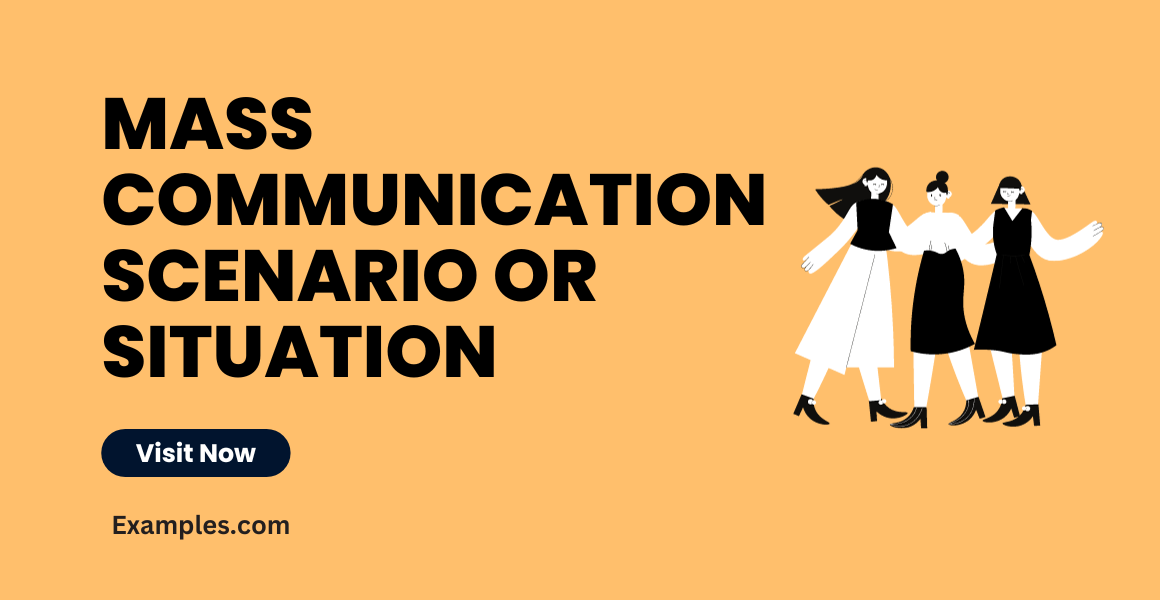40+ Mass Communication Scenarios/ Situations
Dive into the realm of Mass Communication with our in-depth guide, focusing on various scenarios and situations in the field. This resource is a treasure trove for anyone keen on understanding the dynamics of mass communication, from students to professionals. Explore diverse communication styles and strategies employed in media, learn about effective communication in broadcasting, and grasp the nuances of digital communication. Each section is enriched with practical examples, offering insights into the ever-evolving landscape of mass communication scenarios.

Mass Communication Scenario/ Situation
- Breaking News Broadcast: In a breaking news situation, a newsroom must quickly gather accurate information, verify its sources, and broadcast the news promptly and responsibly. The emphasis is on balancing speed with accuracy, ensuring the information is reliable.
- Social Media Campaign for Product Launch: When launching a new product, a company might use social media platforms to reach a wide audience. This involves creating engaging content, leveraging hashtags, and possibly collaborating with influencers.
- Public Service Announcement (PSA) Campaign: PSAs aim to inform and educate the public on important issues. A mass communication strategy here might involve creating impactful messages for TV, radio, and online platforms.
- Crisis Communication Strategy: In a crisis, effective communication is crucial to manage the organization’s reputation and public trust. This might involve press releases, press conferences, and social media updates.
- Documentary Production and Release: Documentaries aim to inform and often advocate on social, historical, or environmental issues. The mass communication strategy would involve researching, filming, and then using platforms like streaming services, film festivals, and educational broadcasts for distribution.
- Election Coverage on National Television: During election periods, media outlets play a critical role in informing the public about candidates, policies, and voting procedures. For instance, a TV network might host debates, provide analysis from political experts, and offer real-time election results, ensuring viewers receive comprehensive and unbiased information.
- Health Awareness Radio Program: Radio remains a powerful tool for reaching wide audiences, particularly in remote areas. A radio program focusing on health education might feature interviews with medical professionals, share health tips, and address listener questions, effectively disseminating important health information.
- Corporate Communication via Annual Reports: Corporations use annual reports to communicate with stakeholders. These reports, often available online and in print, detail financial performance, corporate strategies, and future goals. They serve as a key communication tool to build investor confidence and transparency.
- Educational Content on YouTube Channels: Educational YouTube channels have become significant platforms for mass communication, especially for younger audiences. Channels might cover topics ranging from science to history, using engaging visuals and storytelling to educate and entertain.
- Marketing Campaigns Using Billboards and Print Media: Traditional media like billboards and print still play a vital role in mass communication. An effective campaign might combine eye-catching billboard designs with detailed print advertisements to maximize reach and impact.
- Online News Portals for Global News Delivery: Online news portals offer instant access to global news. These platforms cater to diverse audiences with regular updates, interactive features, and multimedia content, providing a comprehensive news experience.
- Podcasts Addressing Niche Topics: Podcasts have emerged as a popular medium for discussing a wide range of topics. A podcast series might focus on niche subjects, attracting dedicated listeners interested in those specific areas.
- Environmental Campaigns via Social Media Networks: Social media networks are effective for launching environmental campaigns. These campaigns can rapidly mobilize public opinion and action through viral content, hashtags, and online petitions

- Celebrity Interviews on Morning Shows: Television morning shows often feature celebrity interviews, using a mix of casual conversation and promotional content to engage a wide audience and boost ratings.
- Advertising Campaigns for Public Health Initiatives: Public health initiatives utilize mass media advertising campaigns to spread awareness about health issues, often combining striking visuals with compelling narratives.
- Disaster Response and Information Dissemination: During disasters, timely and accurate information dissemination through various media channels can save lives and coordinate relief efforts effectively.
- Film Marketing and Release Strategy: Movie studios use a combination of trailers, press junkets, and social media campaigns to generate buzz and attract audiences for new film releases.
- Music Festivals Promotion through Social Media: Music festivals leverage social media for promotions, using live streams, artist interviews, and fan interactions to build excitement.
- Travel Shows Exploring Global Destinations: Travel shows on TV or online platforms explore global destinations, combining storytelling with stunning visuals to engage and inspire viewers.
- Book Releases and Author Tours: Publishers promote new book releases and author tours using press releases, media interviews, and book signing events to attract readers.
- Awareness Campaigns on Environmental Conservation: Environmental campaigns often use documentaries, infographics, and social media to educate and encourage public action on conservation issues.
- Broadcasting Live Sports Events: Live sports broadcasting combines real-time action with commentary, instant replays, and fan interactions, providing an immersive viewing experience.
- Promoting Educational Web Series for Children: Educational content for children is promoted using engaging and colorful media, often involving interactive elements to enhance learning.
- Technology Product Launches and Demonstrations: Tech companies use live events, online streams, and media coverage to launch new products, showcasing features and demonstrations to tech enthusiasts.
- Food and Cooking Shows for Diverse Audiences: Cooking shows cater to diverse tastes and cultures, often involving celebrity chefs and interactive segments to engage food enthusiasts.

- Fashion Industry Events and Coverage: The fashion industry uses mass communication for event coverage, including runway shows, designer interviews, and behind-the-scenes content.
- Science and Discovery Channel Documentaries: Documentaries on these channels cover a range of topics, using expert interviews and visual storytelling to educate and fascinate viewers.
- Political Campaign Advertising and Messaging: Political campaigns use a mix of advertising, debates, and social media to convey messages and engage with voters.
- Community Radio Programs for Local Issues: Community radio addresses local issues, often involving local personalities and interactive segments with the community.
- Art Exhibitions and Virtual Tours: Art galleries and museums promote exhibitions and offer virtual tours to reach art lovers globally, combining visual appeal with educational content.
- University and College Promotional Campaigns: Higher education institutions use digital campaigns, virtual tours, and alumni testimonials to attract prospective students.
- Corporate Social Responsibility (CSR) Campaigns: Companies use CSR campaigns to showcase their efforts in sustainability and social responsibility, often involving storytelling and community involvement.
- Virtual Reality (VR) Experiences in Storytelling: VR technology is used in immersive storytelling, allowing audiences to experience stories in a highly interactive and engaging manner.
- Interactive Children’s Educational Programming: Utilizing television and online platforms, these programs combine entertainment with learning, often incorporating viewer participation to enhance engagement and education.
- Talk Shows Addressing Social Issues: These shows often feature discussions on pressing social issues, combining celebrity influence with expert opinions to inform and engage the public.
- Coverage of Technological Advancements: Media outlets frequently cover the latest tech trends and innovations, providing insights and analysis that cater to tech-savvy audiences.
- Local News Reporting on Community Events: Local news channels play a crucial role in highlighting community events, issues, and stories, fostering a sense of connection within the community.
- Nature and Wildlife Documentaries: These documentaries educate the public about wildlife and environmental issues, using stunning visuals and storytelling to raise awareness and appreciation.
- Health and Fitness Influencer Campaigns: Influencers on social media platforms share health tips, workout routines, and nutritional advice, influencing a wide range of audiences towards healthier lifestyles.

- Radio Talk Shows on Current Affairs: Radio hosts discuss current events, politics, and cultural issues, often involving listener call-ins for a more interactive experience.
- Satirical News Programs: Blending humor with news reporting, these programs offer a unique perspective on current events, appealing to younger and more diverse audiences.
- User-Generated Content Campaigns: Encouraging audiences to create and share their own content, these campaigns foster community engagement and often go viral on social media.
- Behind-the-Scenes Content in Film and Television: Offering a glimpse into the production process, these segments enhance viewer engagement and interest in the film or TV show.
- Reality TV Shows and Audience Participation: Reality shows often engage viewers through voting or interactive social media campaigns, increasing audience investment in the content.
- Podcasts on Personal Development: Covering topics like self-improvement and life skills, these podcasts offer advice and inspiration, often featuring guest speakers and experts.
- Advertising Campaigns for Automotive Industry: These campaigns combine technical information with appealing visuals and emotional appeal to attract potential buyers.
- Historical Documentaries Providing Educational Content: Through in-depth research and captivating narration, these documentaries educate viewers about historical events and figures.
- Travel Influencers Sharing Experiences: Travel influencers use social media to share their journeys, offering travel tips, destination reviews, and cultural insights.
- Global News Analysis and Commentary: Providing deeper insights into global events, these programs offer comprehensive analysis and diverse viewpoints on international news.
- Multimedia Art Exhibitions Online: Combining various forms of media, these online exhibitions make art accessible globally, often incorporating interactive elements.
How To Use Mass Communication Scenario/Situation?
Effectively utilizing mass communication scenarios or situations requires a strategic approach, blending creativity with analytical insights. Whether it’s a marketing campaign, news broadcast, or social media initiative, understanding how to leverage various mass communication platforms and techniques is key. This guide provides a detailed overview of how to use different mass communication scenarios to your advantage, ensuring your message reaches and resonates with your intended audience.
Understanding Your Audience
- Identify Your Target Audience: Understand who you are communicating with. Demographics, interests, and behaviors are crucial in tailoring your message.
- Research Audience Preferences: Determine the preferred media channels and content types of your audience, whether it’s digital media, traditional print, or broadcast.
Crafting Your Message
- Develop Clear and Compelling Content: Your message should be engaging, clear, and tailored to the medium you are using.
- Use Storytelling Techniques: Stories create emotional connections. Utilize storytelling to make your content more relatable and memorable.
Choosing the Right Medium
- Select Appropriate Channels: Choose channels based on where your audience spends their time. It could be social media, TV, radio, or online platforms.
- Integrate Across Multiple Platforms: For broader reach, use an integrated approach. Coordinate your message across various media for a cohesive campaign.
Timing and Frequency
- Consider Timing: Timing can significantly impact the effectiveness of your communication. Align your messaging with relevant events or audience availability.
- Maintain Consistent Engagement: Regular updates and consistent communication help in building a lasting relationship with your audience.
Measuring Success
- Set Clear Objectives: Define what success looks like, whether it’s increased brand awareness, higher sales, or more website traffic.
- Use Analytics Tools: Track the performance of your campaigns using analytics to understand audience engagement and reach.
Adapting to Feedback
- Monitor Audience Response: Pay attention to how your audience reacts to your communication.
- Be Ready to Pivot: Be flexible and ready to adjust your strategy based on audience feedback and engagement metrics.
Legal and Ethical Considerations
- Understand Legal Constraints: Be aware of legal regulations relating to advertising, content, and broadcasting in different regions.
- Practice Ethical Communication: Ensure your communication is honest, respectful, and does not mislead or offend your audience.
By following these guidelines, you can effectively utilize mass communication scenarios to achieve your communication goals. Whether informing, persuading, or entertaining, the key is to understand your audience, deliver your message effectively, and continually adapt to the changing media landscape.
Tips for Using Mass Communication Scenario/ Situation?
Successfully navigating mass communication scenarios requires a blend of strategic planning, audience understanding, and content adaptability. Whether you’re dealing with a crisis situation, launching a marketing campaign, or disseminating important information, these tips will help you utilize mass communication effectively:
- Understand the Scenario: Clearly define the scenario you’re addressing. Is it a promotional campaign, crisis communication, public service announcement, or something else? Tailoring your approach to the specific scenario is crucial.
- Know Your Audience: Identify who you are communicating with. Different audiences may require different approaches in terms of language, tone, and medium.
- Choose the Right Channels: Select the most effective communication channels for your message. This could include social media, television, radio, print media, or digital platforms, depending on where your audience is most active.
- Create Clear, Engaging Content: Develop content that is clear, concise, and engaging. Your message should be easy to understand and compelling enough to hold the audience’s attention.
- Use a Consistent Tone and Message: Ensure your communication is consistent across all channels. Mixed messages can lead to confusion and diminish the effectiveness of your communication.
- Incorporate Storytelling Elements: People connect with stories. Use storytelling to make your communication more relatable and memorable.
- Monitor and Adapt to Feedback: Pay attention to how your audience responds and be willing to adapt your strategy. Continuous monitoring and flexibility are key in mass communication.
- Ensure Timely Communication: In many scenarios, especially in crisis situations, timely communication is critical. Delayed communication can often lead to misinformation and speculation.
- Leverage Multimedia Elements: Utilize various forms of media — videos, images, infographics — to make your communication more engaging and to cater to different audience preferences.
- Be Culturally Sensitive: Be aware of cultural nuances and ensure your communication is appropriate and sensitive to the cultural context of your audience.
- Measure Effectiveness: Use analytics and feedback to measure the effectiveness of your communication. This can help refine future strategies.
- Stay Ethical and Transparent: Maintain ethical standards and transparency in your communication. Honesty builds trust with your audience.
- Prepare for Crisis Management: In crisis situations, have a plan in place for quick and effective communication to manage the scenario efficiently.
- Encourage Audience Participation: In applicable scenarios, encourage interaction and engagement from your audience. This can increase investment and interest in your message.
- Continuously Update and Inform: Especially in evolving situations, keep your audience continuously informed with the latest updates and information.
Navigating mass communication scenarios effectively is crucial in today’s interconnected world. Whether it’s for disseminating information, managing crises, or driving marketing campaigns, the right strategies in mass communication can significantly impact how a message is received and interpreted by a wide audience. Understanding the audience, choosing appropriate channels, crafting compelling content, and being responsive to feedback are key elements for success. As media landscapes continue to evolve, staying adaptable and informed about the best practices in mass communication remains imperative for any organization or individual seeking to make a meaningful impact.



